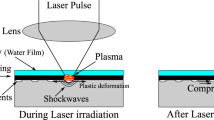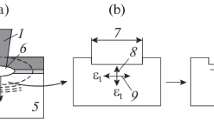Abstract
Laser shock peening (LSP) is an effective surface treatment method used to regulate residual stress and surface roughness of treated materials. In this research, the effect of high strain rate on the velocity of plastic shock waves was analyzed by the Johnson–Cook constitutive model. The transient transmission of a shock wave having different laser-shock-peening parameters was investigated with a three-dimensional finite element method. Firstly, the model validity was experimentally verified, and then, the process parameters were analyzed. In order to determine the effect of high strain rate on the laser shock attenuation, the LSP saturation phenomenon was investigated. The velocity of the plastic shock wave was significantly affected by a high strain rate during the laser peening process. The plastic shock wave velocity was inversely proportional to plastic strain. At the initial stage, the plastic strain increased, the plastic shock wave velocity decreased with the laser power density, and the attenuation gradient of the shock wave pressure increased. When the power density was kept unchanged, the plastic strain and attenuation gradient of the laser shock wave decreased with the number of impacts, and when the number of impacts increased to 3 and 4, the attenuation rate was found to be similar.













Similar content being viewed by others
References
Huang, S., Zhu, Y., Guo, W., Peng, P., Diao, X.G.: Impact toughness and microstructural response of Ti-17 titanium alloy subjected to laser shock peening. Surf. Coat. Technol. 327, 32–41 (2017). https://doi.org/10.1016/j.surfcoat.2017.07.045
Correa, C., Gil-Santos, A., Porro, J.A., Díaz, M., Ocaña, J.L.: Eigenstrain simulation of residual stresses induced by laser shock processing in a Ti6Al4V hip replacement. Mater. Des. 79, 106–114 (2015). https://doi.org/10.1016/j.matdes.2015.04.048
Lu, J.Z., Wu, L.J., Sun, G.F., Luo, K.Y., Zhang, Y.K., Cai, J., Cui, C.Y., Luo, X.M.: Microstructural response and grain refinement mechanism of commercially pure titanium subjected to multiple laser shock peening impacts. Acta Mater. 127, 252–266 (2017). https://doi.org/10.1016/j.actamat.2017.01.050
Huang, S., Zhu, Y., Guo, W., Peng, P., Qiao, H.C., Diao, X.G., Chu, P.K.: Effects of laser shock processing on fatigue crack growth in Ti-17 titanium alloy. J. Mater. Eng. Perform. 26, 813–821 (2017). https://doi.org/10.1007/s11665-017-2507-z
Anjos, A.D., Scheuer, C.J., Brunatto, S.F., Cardoso, R.P.: Low-temperature plasma nitrocarburizing of the AISI 420 martensitic stainless steel: microstructure and process kinetics. Surf. Coat. Technol. 275, 51–57 (2015). https://doi.org/10.1016/j.surfcoat.2015.03.039
Zhang, X.C., Zhang, Y.K., Lu, J.Z., Xuan, F.Z., Wang, Z.D., Tu, S.T.: Improvement of fatigue life of Ti-6Al-4V alloy by laser shock peening. Mater. Sci. Eng. A 527, 3411–3415 (2010). https://doi.org/10.1016/j.msea.2010.01.076
Li, Y., He, W.F., Zhou, Z.: Fatigue crack propagation property of TC17 titanium alloy by laser shock peening. Laser Infrad. 47(10), 1228–1233 (2017). https://doi.org/10.3969/j.issn.1001-5078.2017.10.007 (in Chinese)
Hu, Y.X., Yao, Z.Q., Hu, J., Yao, Z.Q.: Numerical simulation of residual stress field for laser shock processing. Chin. J. Lasers 33(6), 846–851 (2006). https://doi.org/10.3321/j.issn:0258-7025.2006.06.028 (in Chinese)
Hu, Y.X., Yao, Z.Q., Hu, J.: 3-D FEM simulation of laser shock processing. Surf. Coat. Technol. 201, 1426–1435 (2006). https://doi.org/10.1016/j.surfcoat.2006.02.018
Cao, Y.P., Zhou, D.C., Feng, A.X., Hua, G.R., Chen, H.T., Zhu, J.: Simulation and experiment of transmission mechanism on laser shock wave loading 690 high-strength steel sheet. Chin. J. Lasers 43(11), 135–144 (2016). https://doi.org/10.3788/CJL201643.1102010(in Chinese)
Wang, Y.D., Liu, C., Li, C.L.: Evolution of ns pulsed laser induced shock wave on aluminum surface by numerical simulation. Results Phys. 22(103920), 1–7 (2021). https://doi.org/10.1016/j.rinp.2021.103920
Zhang, Y.K., Yu, S.S., Yao, H.B., Wang, F., Ren, A.G., Pei, X.: Experimental study of shock waves induced by high power pulsed laser in AZ31B magnesium alloy. Acta Phys. Sin. 59(8), 5602–5604 (2010). https://doi.org/10.7498/aps.59.5602
Yu, S.S., Yao, H.B., Wang, F., Yuan, B., Zhang, Y.K.: Influence of interaction parameters on high power laser induced shockwave in magnesium alloy. Chin. J. Lasers 37(5), 1386–1890 (2010). https://doi.org/10.3788/CJL20103705.1386 (in Chinese)
Cao, Z.W., Xu, H.Y., Zou, S.K., Che, Z.G.: Investigation of surface integrity on TC17 titanium alloy treated by square-spot laser shock peening. Chin. J. Aeronaut. 25, 650–6 (2012). https://doi.org/10.1016/S1000-9361(11)60429-9
Dai, F.Z., Lu, J.Z., Zhang, Y.K., Luo, K.Y., Wang, Q.W., Zhang, L., Hua, X.J.: Effect of initial surface topography on the surface status of LY2 aluminum alloy treated by laser shock processing. Vacuum 86, 1482–1487 (2012). https://doi.org/10.1016/j.vacuum.2012.02.001
Peyre, P., Sollier, A., Chaieb, I., Berthe, L., Bartnicki, E., Braham, C., Fabbro, R.: FEM simulation of residual stresses induced by laser peening. Eur. Phys. J. Appl. Phys. 23, 83–88 (2003). https://doi.org/10.1051/epjap:2003037
Zhu, R., Zhang, Y.K., Sun, G.F., Shen, X.T., Li, P.: Finite element analysis of surface roughness generated by multiple laser shock peening. Rare Met. Mater. Eng. 47(01), 33–38 (2018). https://doi.org/10.1016/S1875-5372(18)30067-5
Li, Y.J., Chen, D.L., Xiong, L.Q., Zhou, L.C.: Numerical simulation an experimental investigation on the transient transmission of stress wave of TC4 material during laser shock processing. J. Plast. Eng. 18(4), 79–84 (2011). https://doi.org/10.3969/j.issn.1007-2012.2011.04.016 (in Chinese)
Fabbro, R., Peyre, P., Berthe, L., Scherpereel, X.: Physics and applications of laser-shock processing. J. Laser Appl. 10, 265–279 (1998). https://doi.org/10.2351/1.521861
Wang, L.L.: Foundation of Shock Waves. National Defense Industry Press, Chinese (2005) (in Chinese)
Acknowledgements
This work was supported by National Key Research and Development Project (2019YFB2005300, 2019YFB2005305), The National Natural Science Foundation of China (51505236, 51579118), National High Tech ship research project (Ministry of industry and information technology (2019) No. 360), and Nantong Basic Science Research Project (JC2018029, JC2018140, JC2019059, JC2019060).
Author information
Authors and Affiliations
Corresponding author
Additional information
Communicated by P. Hazell.
Publisher's Note
Springer Nature remains neutral with regard to jurisdictional claims in published maps and institutional affiliations.
Rights and permissions
About this article
Cite this article
Su, B., Xu, S., Wang, H. et al. Influence of high strain rate on the transient transmission of laser shock waves. Shock Waves 32, 451–460 (2022). https://doi.org/10.1007/s00193-022-01084-4
Received:
Revised:
Accepted:
Published:
Issue Date:
DOI: https://doi.org/10.1007/s00193-022-01084-4




